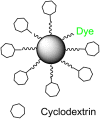Engineering nanoparticles to silence bacterial communication
- PMID: 25806030
- PMCID: PMC4354405
- DOI: 10.3389/fmicb.2015.00189
Engineering nanoparticles to silence bacterial communication
Abstract
The alarming spread of bacterial resistance to traditional antibiotics has warranted the study of alternative antimicrobial agents. Quorum sensing (QS) is a chemical cell-to-cell communication mechanism utilized by bacteria to coordinate group behaviors and establish infections. QS is integral to bacterial survival, and therefore provides a unique target for antimicrobial therapy. In this study, silicon dioxide nanoparticles (Si-NP) were engineered to target the signaling molecules [i.e., acylhomoserine lactones (HSLs)] used for QS in order to halt bacterial communication. Specifically, when Si-NP were surface functionalized with β-cyclodextrin (β-CD), then added to cultures of bacteria (Vibrio fischeri), whose luminous output depends upon HSL-mediated QS, the cell-to-cell communication was dramatically reduced. Reductions in luminescence were further verified by quantitative polymerase chain reaction (qPCR) analyses of luminescence genes. Binding of HSLs to Si-NPs was examined using nuclear magnetic resonance (NMR) spectroscopy. The results indicated that by delivering high concentrations of engineered NPs with associated quenching compounds, the chemical signals were removed from the immediate bacterial environment. In actively-metabolizing cultures, this treatment blocked the ability of bacteria to communicate and regulate QS, effectively silencing and isolating the cells. Si-NPs provide a scaffold and critical stepping-stone for more pointed developments in antimicrobial therapy, especially with regard to QS-a target that will reduce resistance pressures imposed by traditional antibiotics.
Keywords: nanomedicine; nanoparticles; quorum quenching; quorum sensing.
Figures



References
-
- Cash B. M., Wang L., Benicewicz B. C. (2012). The preparation and characterization of carboxylic acid-coated silica nanoparticles. J. Polym. Sci. A Polym. Chem. 50, 2533–2540 10.1002/pola.26029 - DOI
LinkOut - more resources
Full Text Sources
Other Literature Sources
Miscellaneous

